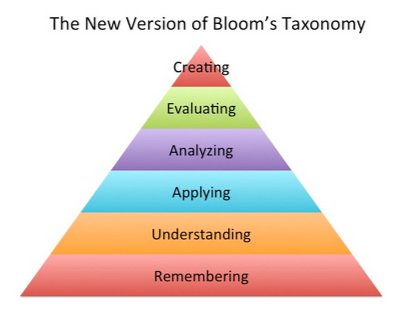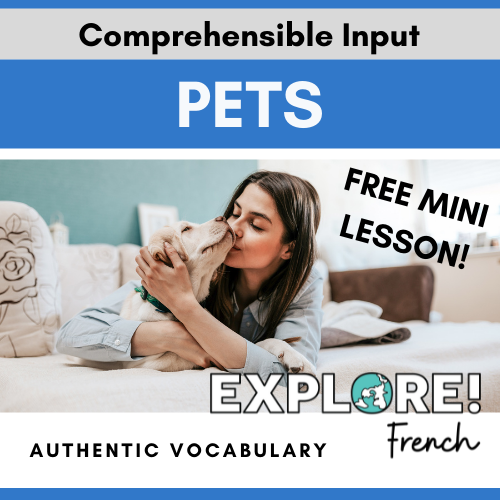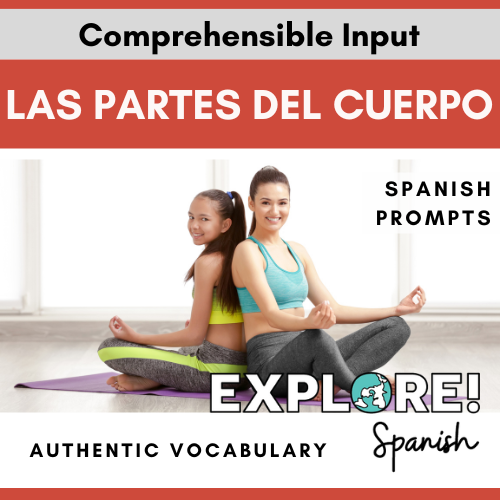Authentic Vocabulary Instruction
Teaching vocabulary within cultural and linguistic context
I was 20 minutes into a vocabulary introduction and I was losing them. Despite my best efforts to be animated as I methodically worked through the words on my list, kids were staring into space, sneaking peeks on their phones, and packing up their books five minutes early. I knew I was boring them, but I didn’t know what to do.
The bell rang and my students slammed their books shut and bolted for the door. I sighed. Thank goodness that was behind me. Tomorrow we could start working on fun stuff.
“I realized that huge chunks of my instruction were 100% focused on the bottom tier of Bloom’s Taxonomy - remembering.”
Although my instructional practice changed a lot in my first 15 years of teaching, the way I introduced vocabulary didn’t change much at all. My vocabulary instruction went something like this:
I give students a list of vocabulary words. (this might come from a textbook page from the early 2000’s, a document provided by my school or district, or perhaps a list I curated myself. The words are important. (umm… ignore the word for ‘cassette tape’, kids!) I usually add some cute clip art for my visual learners.
I walk through the vocab list item by item with students, sharing definitions, pronunciation, and usage tips. I try to be entertaining and share cultural connections, but vocab introduction day is never the world’s greatest lesson. (My stand-up routine could use some work).
Sometimes, I send students to reference materials like dictionaries or Quizlet to get the definitions. Some students do great with this, but some do a mediocre job and end up with lots of errors in their list. Why is it so hard to take accurate notes?!?
We use a lot of class time to practice and memorize the new words. I’m pretty creative, so I bring a lot of engaging games and activities to vocabulary practice. I integrate technology! I give students choices of activities! I incorporate color, music, and movement! I use a lot of research-based techniques to help students learn. All of this is great (and I’m not criticizing it, by the way - I still use these types of activities to reinforce learning and I hope you do too!) The end goal is for students to thoroughly memorize the list I gave them.
Students demonstrate their mastery on some type of production-based assessment.
I integrate the vocabulary as much as possible into subsequent instruction.
All of this was instructionally sound, and was generally effective. I enjoyed coming up with new vocabulary activities. My students (for the most part) liked doing them. Yes, there was some drill-and-kill involved, but that’s simple reality! And anyway, I reasoned, this is mitigated by all the engaging activities we do to help with memorization.
Still… something bothered me. Each time I handed out a new vocab list, I had to spend a lot of time walking through each word and carefully giving students pronunciation notes and other details of definitions and usage. It took forever. It was boring. It was teacher driven; I talked while my students dutifully (or not-so-dutifully!) took notes.
Then I started thinking about Bloom’s Taxonomy. Where did my vocabulary instruction fall?
I realized that huge chunks of my instruction were 100% focused on that bottom tier - remembering. Not where I wanted to be.
Worst of all was the feedback I received from some of my weaker students. While the high-fliers generally enjoyed the vocabulary segment of class, here’s what some students said about vocabulary:
“I usually forget it after the quiz or test.”
“Flashcards are dull. Working on every word is like a chore.”
“It’s boring!”
This feedback was tough to hear. But, if I was really honest with myself, what my students were telling me mirrored what I already knew. My vocabulary introduction was weak. I wanted my class to be better.
I began to do some vocabulary-soul-searching. Like my students, I am also a language learner. How do I learn vocabulary in my real life? I realized most of my learning comes from reading and listening to native language, and it takes time to absorb. Often, I learn new vocabulary when I’m working on a task in the target language, and suddenly a new word makes sense. It’s not that I never look up a word - I do, when I really need one - and I occasionally even give myself a list to memorize. But mainly, I learn words in their natural context in the same places a native speaker would encounter them. And, importantly, I am the one who decides which words I want and need to incorporate into my active vocabulary.
“My task is to curate comprehensible source documents, to develop achievable tasks for my students, and to coach students in their use strategies through the discovery process.”
I never gave my students that kind of power and responsibility for their own learning. I told them exactly what to learn and when to learn it.
I started looking for ways to replicate my own vocabulary learning process with my students. And the Authentic Vocabulary series was born!
Here’s how it works:
Step 1. I select a text (video or print) that uses the target vocabulary. The text must be an authentic, target-language source where native speakers would naturally encounter the vocabulary.
Step 2. I give students a task to complete in the target language. (Examples would be to create a shopping list for a specific event, or to list the most important words you need to navigate a given situation). Students must complete this task using ONLY the target language source. No translators!
This step is the heart of the Authentic Vocabulary approach. Students are used to gathering this type of information in their first language (from online shopping sites, gaming sites or how-to videos, for example), and they bring those skills to the target language. Students must synthesize their current target language skills, their understanding of cognates, and graphic cues to make inferences about word meanings. They must develop theories and test them. There’s a lot of content they don’t understand, and sometimes they make mistakes… and students learn to be comfortable with both of those realities. Bit by bit, they build comprehension.
Another amazing byproduct of Authentic Vocabulary is natural differentiation. Students have some freedom to pursue their interests and to make judgments about what’s important to them. As a result, some kids will be happy to learn the word ‘shoe’ while others will go deeper into vocabulary like ‘sandal’ ‘boot’ and ‘high heel’- words which I previously introduced to students only in upper levels, if at all. The kids who are interested in the topic will go deeper, all by themselves. This is fabulous!
Click the images below to see my Authentic Vocabulary Collection on my TPT store (including some freebies!)
But wait, there’s more.
Step 3: Students collaborate to refine the vocabulary they discovered, and eventually as a class we develop a list of the most important words we want to learn.
A couple of amazing things happen at this step. First, 90% of the words students choose are exactly the words I would have chosen for them. The process actually helps kids develop awareness about their language learning needs! Second, by the time we get to this step students have already had so many exposures to the new vocabulary that it’s not foreign anymore. They still have to study some, and I still use all those amazing vocabulary practice activities. But, the process is more natural. The learning is deeper. The kids have more buy-in.
Now, as the only French teacher in my school I’m blessed with near total curricular autonomy. Maybe you have vocab lists you’re required to deliver to students.
No worries. Just hold off on handing out that list for a couple of days, and start with an Authentic Vocabulary approach. I guarantee, when you eventually give students your vocab list they’ll already be familiar with a large percentage of the words on it. Think of the Authentic Vocabulary lesson as investing time in learning the vocabulary before you introduce your list instead of after.
Step 4. We do work through the list as a class, and pronunciation in particular often needs clarified. But this step goes quickly and students are more engaged, as they already have experience with this vocabulary and have bought into its importance.
Now, I recognize there are some drawbacks to this approach. Is it messy? Yes. Time consuming? Yes. Do students make mistakes? They do.
Is it effective? A resounding YES!
““By the time you explain the vocabulary, I already know most of the words” ”
My role in my classroom has changed. I still lead instruction, of course, but it’s more behind the scenes. I don’t stand at the front and deliver much information about vocabulary anymore. My task is to curate comprehensible source documents, to develop achievable tasks for my students, and to coach students in their use strategies through the discovery process. However, I no longer tell students exactly what to learn; they figure this out for themselves. This approach puts the students uniquely in charge of their own learning and the results are almost magical.
Kids work hard. They make unique discoveries. They evaluate options and made judgement calls. They collaborate and negotiate meaning. In short, they don’t just learn vocabulary, they learn HOW to learn vocabulary.
Back to Bloom’s Taxonomy:
My new vocabulary instruction is right up at the top! It’s the same content, but the learning is so much deeper.
My students noticed too! Here’s what they said:
“Finding vocabulary on the website was my favorite activity in this unit because it showed me tons of new words. I actually think it's one of the best activities that we've done all school year.” (Will, 7th grader)
“I liked writing about myself at the bottom, and I liked that I could figure it out for myself. I didn’t have to be told.” (Grace, 9th grader)
“After we did the vocabulary lesson, I went home and changed the language on (my video game) to French. I figured out that ‘la terre’ means earth, and then I thought of ‘terrarium’ and ‘terrestrial’ and I realized that it’s really fun to learn vocabulary.” (Alex - 8th grader)
“In my Spanish class we look at a list and one person says the word, and then another person says the word. But this was a good way to learn a language. I’m better at seeing pictures than at reading stuff.” (Kelsey, 4th grader)
“Reading the website shows me how much I understand. I’m not afraid of looking at a hard reading assignment because I realized I can do it.” (Jasmine - 6th grader)
Yes, those are real student quotes!
My students are developing confidence, flexibility, and satisfaction in their language-learning journey - exactly what I want for them!
Do you have a unique approach to teaching vocabulary? I’d love to hear about it in the comments below.
See my entire Authentic Vocabulary lesson series in French and in Spanish on my Teachers Pay Teachers store









